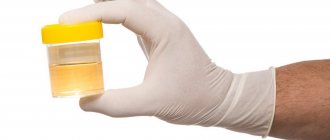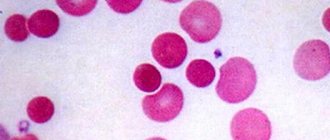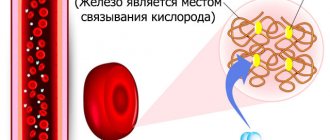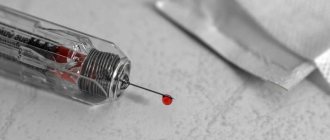When can red blood cells appear in a child’s urine?
Is it possible for red blood cells to appear in the urine of a healthy child?
The appearance of red blood cells in the urine is usually called hematuria or erythrocyturia.
Normally, a child may have a small amount of red blood cells in his urine. On average, no more than 5 in the field of view. Of course, it would be best if there were none at all. There are many different physiological and pathological processes during which red blood cells appear in the urine.
Pathological conditions
The appearance of red blood cells in the urine of a child can be classified into microhematuria and macrohematuria.
Gross hematuria is a condition in which the urine changes color to different shades of red depending on the number of red blood cells. “Macro” means that this type of hematuria is not visible to the naked eye.
Microhematuria is characterized by normal urine color, but microscopic examination reveals red blood cells.
Microscopic examination of sediment is an important way to determine substances in urine. This way, not only blood elements can be detected, but also salts, bacteria, epithelium, and casts.
There is a classification of the causes of hematuria into renal, prerenal and postrenal.
Renal hematuria (renal) is caused by impaired renal function, or more precisely by impaired permeability of the nephron glomerular membrane or damage to the renal tubules. This is observed when:
- glomerulonephritis – damage to the glomeruli of the kidneys;
- pyelonephritis – damage to the kidney tubules caused by bacteria;
- tumors;
- kidney tuberculosis;
- kidney infarction, etc.
Prerenal causes of the appearance of red blood cells in the urine are due to impaired vascular permeability; the glomerular membrane of the kidneys is not damaged. This occurs with hemorrhagic diathesis, vasculitis, coagulopathies, and so on.
Based on the name, the cause of postrenal hematuria will be pathology of the urinary tract. Kidney function remains normal or may be impaired.
The cause of such hematuria may be injury from a stone to the urethra due to urolithiasis. Trauma or inflammation of the urethra also leads to postrenal hematuria:
- cystitis - inflammation of the bladder;
- pyelitis - an inflammatory process of the pelvis affecting the mucous membrane;
- urethritis - inflammation of the urethra;
- tumors on the path of urine excretion from the body.
Unrelated hematuria
There are a number of conditions in which red blood cells may temporarily appear in the urine. These include:
- increased physical activity;
- overheat;
- hypothermia;
- hyperlordosis;
- influenza, rubella, scarlet fever, infectious mononucleosis.
In these conditions, increased red blood cells may be detected in the child’s urine, but after some time everything returns to normal.
False hematuria
If red urine appears, do not be upset. Perhaps this is false hematuria. It occurs as a result of the appearance of other compounds (not red blood cells) in the urine, giving it such a color. For example, these can be food dyes (consumption of beets), porphyrins, some medications, myoglobin.
Phenazopyridine gives urine a red color.
Therefore, before donating urine for analysis, you need to properly prepare to avoid false research results.
What is false hematuria
Pseudogematuria is a term for a change in the color of urine. It becomes bright pink or brown, but laboratory analysis does not detect traces of blood cells in the child’s urine. This condition is not considered a pathology, but only indicates physiological causes.
In infants and infants up to one year old, a rich yellow, almost orange tint of urine is considered normal. The change in its color in older children is due to diet, namely the presence in it of products containing coloring pigments:
- tomatoes;
- carrot;
- beet;
- rhubarb;
- raspberries;
- blackberry;
- cherry;
- black currant;
- pomegranate.
These properties are also inherent in some products with artificial colors - sweet carbonated drinks, store-bought juices, chips, crackers. In this case, the urine turns red but remains clear. There are no pathological symptoms accompanying the process of urination, and there is no deterioration in the child’s well-being.
False hematuria - reddish color of urine - also appears after taking certain medications, since the pigment present in them is excreted by the kidneys.
Such medications include:
- vitamin B12;
- acetylsalicylic acid;
- phenolphthalein;
- sulfonamides;
- antibiotics – Rifampicin, Metronidazole.
False hematuria is often caused by problems with the liver or gall bladder. Therefore, if the shade changes, you should contact a pediatric urologist.
Preparing for analysis
Before submitting your urine for analysis, you should not eat foods that can color it.
Do not exhaust your body with training. This may affect the outcome of the study.
Before collecting biological material, it is necessary to toilet the external genitalia.
A container for collecting urine should be prepared in advance: for small children - urinals, for children who can control the urination process - a container from a pharmacy.
You can use a baby food jar as a container, after sterilizing it first.
It is necessary to collect an average portion of morning urine in a container.
Collected urine should be brought to the laboratory no later than 2 hours after urination.
Pyelonephritis in a baby
This is an infectious inflammation that affects the kidneys, in particular the pelvis and calyces. It is caused by bacteria, viruses, protozoa or fungi. The most common infections are Escherichia coli, Proteus and Staphylococcus aureus; Viral pathogens (adenovirus, influenza viruses, Coxsackie viruses) are less common. In chronic pyelonephritis, there may be several pathogens at once.
An infection can get into the kidneys in different ways - through the blood and lymph from other organs and systems (for example, with pneumonia, pathogens enter the urinary system through the blood), or directly from the excretory organs due to insufficient hygiene or medical procedures.
Symptoms of pyelonephritis coincide with signs of infectious inflammation. It can be:
- increased temperature for no apparent reason;
- change in the color and odor of urine;
- lower back pain;
- periumbilical region;
- change in the nature of urination (decrease or increase in frequency of urge and amount of urine, pain during urination);
- puffiness and bags under the eyes;
- loss of appetite;
- weakness;
- pale skin;
- nausea;
- vomit.
Inflammation of the external genitalia and weight loss are possible.
Treatment requires hospitalization in a specialized urological or nephrological department, where the child is prescribed bed rest, a diet with plenty of fluids, and drug therapy. Antibacterial drugs are usually prescribed that are effective against specific pathogens, but are safe for the urinary system. These include antibiotics - penicillins, cephalosporins, etc. Additionally, diuretics, antiseptics, and painkillers are prescribed. If necessary, the drug complex can be supplemented with immune-strengthening drugs and probiotics.
Additional research methods
If red blood cells are detected in a child’s urine, additional research is required to clarify the cause of the possible condition.
One such study is the three-glass test. The process of urination is carried out in three different containers (“glasses”). The detection of red blood cells in each of them will indicate the pathology of a certain area of the urinary system.
An ultrasound examination of the kidneys may also be prescribed.
Microbiological examination of urine will detect bacteria in the urine, determine their type, and prescribe therapy, excluding drugs to which microorganisms may be resistant.
Urethritis in children
The disease is an inflammation of the urethral mucosa. It manifests itself in the form of pain, pain, burning during urination, pain in the lower abdomen, increased body temperature and fatigue. Often, the manifestations of the disease differ according to the patient’s gender: boys experience white discharge, burning when urinating, itching of the penis, hematuria, and cloudy urine. Girls more often experience pain during urination and in the lower abdomen, itching of the external genitalia, and frequent urge to go to the toilet.
The causes of urethritis can be infectious or non-infectious. Depending on what caused the inflammation, treatment is selected. If the cause of urethritis is an allergy, antiallergic therapy is prescribed. Depending on the form of the disease (acute, chronic), the type of infectious agent and the individual characteristics of the small patient, various drugs are used. If the source of the disease is bacteria, a course of antibiotics is prescribed. Treatment should be accompanied by bed rest, installation of anti-inflammatory and antibacterial agents into the urethra.
Treatment is usually carried out at home. Hospitalization is required only in acute cases and complications.
Normal urine test for a child
I would like to give an idea of normal indicators, including what the norm of red blood cells in a child’s urine should be.
| Index | Norm |
| Color | Straw yellow |
| Smell | Not harsh |
| Specific gravity | 1,003 – 1,035 |
| pH | 5 – 7 |
| Transparency | Transparent |
| Protein | Not detected |
| Sugar | Not detected |
| Ketone bodies | Not detected |
| Bilirubin | Not detected |
| Red blood cells | Up to 3 – 5 in sight |
| Leukocytes | Up to 5 in sight |
| Cylinders (hyaline, waxy, granular) | Not detected |
| Bacteria | Not detected |
| Yeast-like fungi | Not detected |
| Salts | Can be |
Collection of material
In a number of cases, situations arise when, despite a generally normal state of health, a urine test turns out to be quite bad. This is possible due to improper collection of this biological material.
Thus, the first morning urine, which is the most concentrated, is optimal for analysis. In addition, the child must be rested to eliminate the possibility of the so-called “marching test”, which will reveal increased red blood cells in the urine. They are elevated in children after physical activity much more often than in adults.
It is necessary to pay very close attention to the hygiene of the genital organs of both boys and girls. It is advisable to collect a medium portion of urine by placing the jar during urination.
When should you not be alarmed?
The number of red blood cells directly in children's urine can fluctuate from year to year. For example, in infants, immediately after birth, maternal corpuscles are actively utilized, since their own hematopoietic system begins to work at full capacity. Therefore, in the first days of life, the following is often detected in a baby:
- uric acid diathesis;
- physiological jaundice.
Urine analysis always reveals a considerable amount of old red blood cells. Moreover, the indicators are sometimes up to 7 units at the microscope focus. It is difficult to say how long this process will last, since everything depends on the adaptive properties of the newborn’s body.











